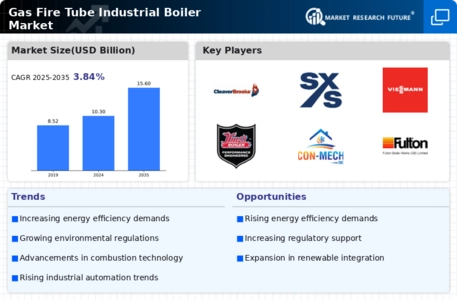Shift Towards Cleaner Energy Sources
The Gas Fire Tube Industrial Boiler Market is experiencing a shift towards cleaner energy sources, driven by the global push for sustainability. Natural gas, as a cleaner alternative to coal and oil, is gaining traction in industrial applications. The transition to gas-fired systems is being encouraged by both economic and environmental factors, as natural gas combustion produces fewer pollutants. This shift is likely to result in increased investments in gas fire tube boilers, with market analysts projecting a growth rate of around 5% annually. The trend towards cleaner energy not only aligns with regulatory requirements but also meets the growing consumer demand for environmentally friendly practices. Consequently, the Gas Fire Tube Industrial Boiler Market is poised for expansion as industries adapt to this evolving energy landscape.
Increasing Demand for Energy Efficiency
The Gas Fire Tube Industrial Boiler Market is experiencing a notable surge in demand for energy-efficient solutions. Industries are increasingly prioritizing energy conservation to reduce operational costs and comply with stringent regulations. The implementation of advanced technologies in gas fire tube boilers enhances thermal efficiency, which can exceed 90%. This efficiency not only lowers fuel consumption but also minimizes greenhouse gas emissions, aligning with global sustainability goals. As industries seek to optimize their energy usage, the market for gas fire tube boilers is projected to grow, with estimates suggesting a compound annual growth rate of around 5% over the next five years. This trend indicates a robust shift towards energy-efficient systems, positioning the Gas Fire Tube Industrial Boiler Market favorably for future investments.
Technological Innovations in Boiler Design
The Gas Fire Tube Industrial Boiler Market is witnessing rapid technological advancements that enhance boiler performance and reliability. Innovations such as smart controls, advanced heat exchangers, and improved combustion technologies are being integrated into gas fire tube boilers. These advancements not only improve efficiency but also facilitate predictive maintenance, reducing downtime and operational costs. The introduction of IoT-enabled systems allows for real-time monitoring and optimization of boiler operations, which is becoming increasingly essential in competitive markets. As industries adopt these cutting-edge technologies, the market is expected to grow, with projections indicating a potential increase in market size by 7% over the next few years. This trend underscores the importance of innovation in the Gas Fire Tube Industrial Boiler Market.
Regulatory Compliance and Environmental Standards
The Gas Fire Tube Industrial Boiler Market is significantly influenced by the increasing stringency of environmental regulations. Governments worldwide are implementing stricter emissions standards to combat climate change and promote cleaner technologies. As a result, industries are compelled to upgrade their boiler systems to meet these regulations. Gas fire tube boilers, known for their lower emissions compared to traditional systems, are becoming a preferred choice. The market is likely to see a rise in demand as companies invest in compliant technologies. Recent data indicates that the market for gas fire tube boilers could expand by approximately 6% annually, driven by the need for compliance with evolving environmental standards. This regulatory landscape presents both challenges and opportunities for the Gas Fire Tube Industrial Boiler Market.
Rising Industrialization and Infrastructure Development
The Gas Fire Tube Industrial Boiler Market is benefiting from the ongoing industrialization and infrastructure development across various regions. As economies expand, there is a heightened demand for reliable and efficient heating solutions in manufacturing, construction, and energy sectors. The growth of industries such as food processing, pharmaceuticals, and textiles is driving the need for gas fire tube boilers, which offer efficient heating solutions. Recent reports suggest that the industrial sector's growth could lead to an increase in boiler installations by approximately 8% in the coming years. This trend indicates a robust market opportunity for the Gas Fire Tube Industrial Boiler Market, as businesses seek to enhance their operational efficiency and meet production demands.


















Leave a Comment